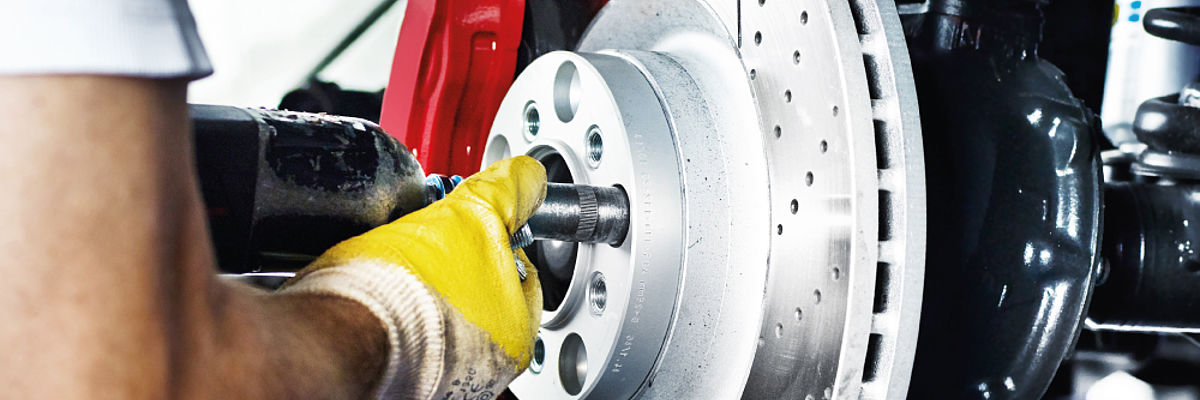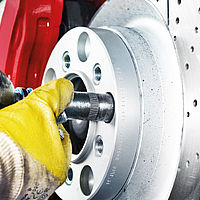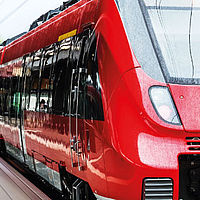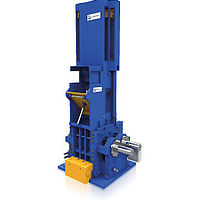They can be found in all kinds of vehicles. They are used in escalators, washing machines, wind turbines and closed-dye forging presses – as well as in many other industrial machines and those of everyday life. We’re talking about brake linings. Wherever they are used, they represent a vital component of safety, meaning that their quality is a non-negotiable. And this quality depends directly on the friction material formulations and the mixing process used to produce them. From a technical point of view, the preparation of friction lining mixtures is very challenging. The challenges in these applications include the wide variety of raw materials used, and, dependent on a particular formula, the ratio between the filler and polymer shares, which is typical of friction lining material formulations.
Numerous requirements
‘Friction linings must have a highly stable friction coefficient and temperature resistance, must be moisture-repellent and exhibit low noise characteristics and high mechanical strength. They should offer extremely long service life and keep brake disk wear to a minimum. Moreover, they should prevent smoke generation and – for some years now – they also need to be environmentally friendly,’ says Dirk Herkrath, CEO of Becorit, in listing the requirements of friction linings. The German company Becorit GmbH, a subsidiary of the US-based Wabtec Corporation, is one of the major suppliers of brake linings. At their site in Recklinghausen, Germany, they produce disk brake linings and plastic brake shoes for rail cars and special brake linings for mining and industrial applications.
Overall, the application spectrum of friction linings can be divided into three major areas, with the largest share being used in automotive applications such as brake linings and cladding or clutch linings for passenger cars and lorries. Then is a much smaller railway market. Brake linings for disk brakes and brake shoes for wheel brakes form the main share of this segment. Due to differences in sizes and specifications, they require a range of different material properties. The third segment in the market concerns industrial applications. This segment includes brake linings, clutch linings, sliding elements, friction belts, rollers and bands, disks and dampers for a large variety of machines.
Francesco Laureri, Technical Director of ITT Friction, one of the world’s largest suppliers of brake and friction linings for the automotive industry, sums up the essential criteria in today’s automotive environment this way: ‘Customer-specific requirements relative to consistently high quality and extremely low wear have become tremendously demanding in recent years. In addition, our sector now places a higher and higher value on comfort considerations, such as on low-noise operation. And environmental aspects are also gaining daily in importance. In 2014, for example, ITT took yet another ecologically minded step by introducing copper-free linings in original equipment components.’
The different applications require different mixtures. Most automotive applications use two-stage mixtures. In this type of mixture, a ‘wet’ pre-mix is added to the ‘dry’ mixture in a second step. The difference between the ‘wet’ and ‘dry’ mixtures is due to the type of binder used. The material specifications require a combination of flexibility and stiffness, good performance and comfort with minimal wear. Most of the ‘wet’ blends are used in the railway segment and in industry. One essential requirement for the friction material in the railway sector is pliability, so that it can conform to large track or brake disk geometries. Because the brake components used in trains have a three to five times larger braking surface than those used in cars.
Different production processes
For the production of ‘wet’ mixtures, three different processes have become most prevalent. The first is that which is used primarily in automobile production. Here wet mixtures are used either as a finished mixture for the brake linings or as masterbatches for yarn impregnation in clutch surfaces. The mixing systems used here consist of an interior mixer with a downstream rolling mill mixer and subsequent pelletisation.
The second method is that used for railway brake linings and industrial wear parts. As a general rule, the material here has a high rubber content and can be pressed into various shapes at room temperature, without prior melting or use of a binder compound. This type of production allows for a high share of filler to be present in the mixture. A production line comprises an interior mixer with pelletisation. The most common example of an application for this process is the manufacture of pelletised friction lining mixtures which can be moulded by hot or cold compression. The production must be carried out in special interior mixers whose mixing chambers are protected against excessive wear. The advantage of this method is its extremely short compression and moulding times. The stiffness of the material must be high enough to ensure that the geometries moulded from the press do not flow while curing. It is nonetheless also possible to use hot presses for moulding.
The third method is the manufacture of pelletised mixtures for rolling mill mixers: this method uses an interior mixer coupled with a pelletiser unit and subsequent calender machine to form the resulting mixture into a skin for stamping. Typical applications are the production of pelletised friction material mixtures with high rubber content. In the course of further production, pellets are formed, cut in rollers and dried, and finally stamped into different shapes. To prevent cracks and damage to the surface of the material after rolling, the formulation must not contain any highly filled materials. The mixture must be very pliable and have a low viscosity, so that it can be processed into thin rolls in a one operation.
The advantages of interior mixer technology
The mixers used in the production of friction lining mixtures have to satisfy many requirements: they must be able to process high fibre quantities and low rubber quantities without solvents. At the same time, they must also feature high wear protection against abrasion and be capable of high throughput. That’s why the interior mixer is often the machine of choice.
Interior mixers offer many advantages in the production of friction lining mixtures. They enable the composition and production of highly filled mixtures in short processing times. In addition, only interior mixers can condition the mixture for cold pressing. This allows for cost-effective production of parts in high quantities and short, fixed cycles. And the quality of the mixtures is also very good.
Due to its cooling capacity, the model IM 135E interior mixer from the HF MIXING GROUP is the machine for mixing friction lining materials. Its PES5 rotors with intermeshing rotor geometry ensure that all of the mixing components are distributed homogeneously and that the mixture has an extremely high degree of dispersion. Moreover, the rotor design and the optimised cooling characteristics of all of the machinery components that come in contact with the mixing goods also make it possible to process heat-sensitive materials efficiently. As a result of these properties, the Intermix® 135E has established itself in the friction linings industry.
Dirk Herkrath of Becorit maintains: ‘The main advantage of an interior mixer is the ability to process rubber bales without solvents. Today especially, everyone is trying to eliminate the use of any solvents which could be problematic for the environment or safety.’ The only disadvantages he sees are the relatively high mixing costs due to smaller batch sizes, along with increased energy requirement of the mixing process.
Herkrath’s assessment of the future of his industry reflects a nuanced view: ‘It will indeed be possible to achieve growth in low-noise goods transport and in the metro segment as well as on the Chinese market in general, which continues to be a growth market. It will be exciting to see how the development of e-mobility will affect our industry. Conventional brake systems which are associated with the friction materials will always be indispensable. E-mobility is already the state-of-the-art in railway traffic. But modern trains, in particular, also use electric braking for reasons of energy storage. For this reason, friction lining consumption might decline in the future.’
We also see a high degree of automation as one of the major success factors in the future for our growth in China and North America. ‘Our industry is subject to high price pressure. But since nobody wants to compromise on the quality of the friction linings, the manufacturers have to look at other aspects, such as automation. We’re well on our way there, because the degree of automation at ITT is already very high. The number of robots now exceeds the number of employees (whose qualification is growing continuously).’ With regard to automation, however, Laureri still also sees an obligation on the part of the machinery suppliers: ‘A seamless process monitoring and online support system for all machines is extremely important to us.’





